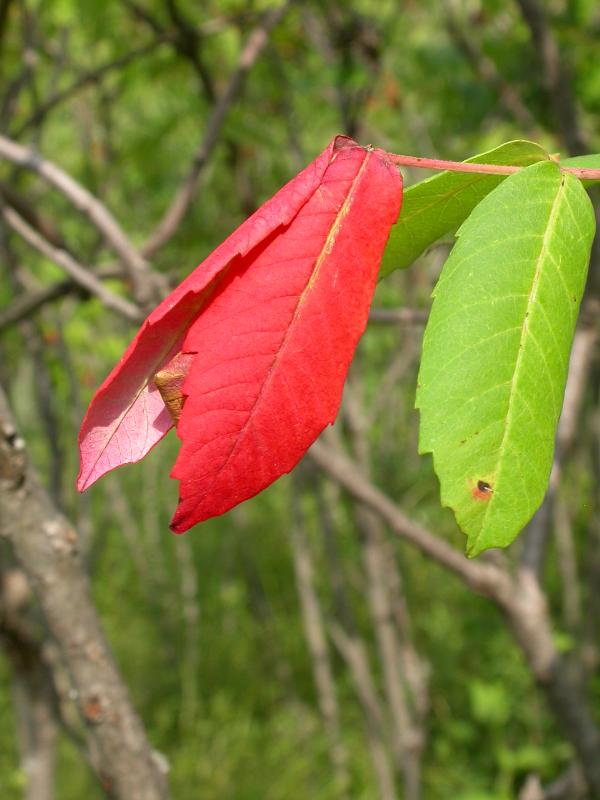
If you haven’t found them
yet, when you go for this one you should do
Keys to the Kingdom and
It’s Elemental My Dear Watson! at the same time.
The leaves of the sumac
that surround this cache turn a bright red in the fall. Contrary to what I was told when
growing up, the bright red of sumac or any autumn leaf is NOT masked by
green chlorophyll
during the spring and summer months. The masking theory is easily
debunked. One only needs to look for what should be a great change
in the color of the leaf when backlit. If red is sandwiched between
the green it’ll definitely change the color of the transmitted
light, even if it not visible when the light is simply reflected
from the leaf. However, there is no difference in color, therefore
the red
is NOT present when the leaf
is green!
Look at the picture on
the left here and imagine that red being
somehow "masked" by a thin layer of
green.
Especially in transmitted
light! No way Hosay!
According to
THE
CHEMISTRY OF AUTUMN COLORS, in the autumn, once the leaf is cut
off from the rest of the tree, "the production of chlorophyll in
the leaf declines, and the green color of the leaf fades. If the
leaf contains carotene, as do the leaves of birch and hickory, it
will change from green to bright yellow as the chlorophyll
disappears. [Editor’s note: the yellow is there all year
long. All leaves contain at least some carotene. It contributes to
the overall color of the leaf, making it more of a yellowish green
than what it would be if chlorophyll were the only pigment. As a
former photographer in industry I used to have to recognize the
amount of various colors that were present in color photographs I
printed. I can easily detect the yellow in the green (or should I
say greenish) leaves I see in the summer months.] In some
trees, as the concentration of sugar in the leaf increases, the
sugar reacts to form anthocyanins. These pigments cause the
yellowing leaves to turn red. Red maples, red oaks, and sumac
produce anthocyanins in abundance and display the brightest reds
and purples in the autumn landscape. "I just read (9/22/09)
an
article that delves into a new theory about why American fall
colors are more colorful than those in England. Here is
another
article (read on 9/30/09) that explains the colors
well.
Check out the
USDA-Forest
Service Regional Fall Foliage Sites for updated info about fall
color in the eastern part of the US.
A little farther south of
this cache are
clumps of fuzzy berries on some other sumacs. Try nibbling on
the red
berries when they are ripe.
They taste a lot like lemonade and are loaded with vitamin C. I
tasted them when I set out this cache. They were pretty
good.
Thanks to ricann for
providing the container for this cache!! It was a
gift.